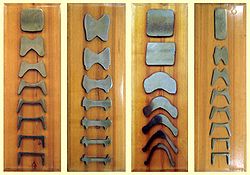
Structural shape rolling, also known as shape rolling and profile rolling,[1] is the rolling and roll forming of structural shapes by passing them through a rolling mill to bend or deform the workpiece to a desired shape while maintaining a constant cross-section. Structural shapes that can be made with this metal forming process include I-beams, H-beams, T-beams, U-beams, angle iron, channels, bar stock, and railroad rails.[1] The most commonly rolled material is structural steel, including carbon steel and stainless steel.[2] Other metals,[citation needed] plastic,[citation needed] paper,[citation needed] and glass[citation needed] can also be rolled. Common applications include railroads, bridges, roller coasters, art, and architectural applications.
It is a cost-effective way of bending these materials because the process requires less set-up time and uses pre-made dies that are changed according to the shape and dimension of the workpiece.[3] This process can roll workpieces into full circles.
Structural shape rolling uses profile rolling techniques where the workpiece is passed through a series of flatteners (of larger magnitude than most common rolling devices) that match the workpieces' cross-section. The most common method uses 3 rollers; the bending is controlled by varying the distance between the rollers.
Structural shapes can be rolled in different ways such as the “easy-way”, the “hard-way”, heel in/out, ball in/out, leg in/out, stem in/out, and off axis. The hard-way would be bending the workpiece in the orientation where its moment of inertia is the greatest. The easy-way is bending the workpiece along the axis with the smallest moment of inertia. For example, a piece of angle iron rolled the easy-way would be rolled along one of its flanges, while the hard-way would be along the angle itself.[4]